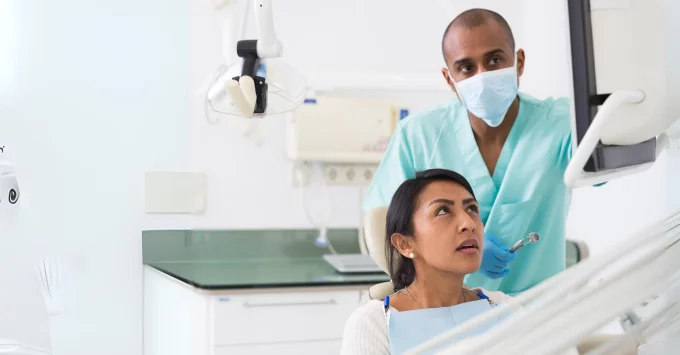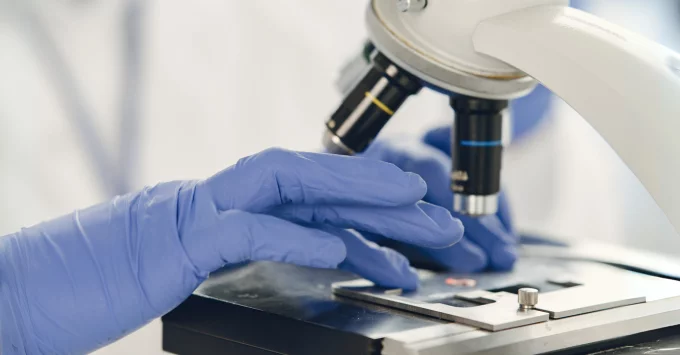By Susan S. Wingrove, BS, RDH
August 21, 2025
Don’t miss Ms. Wingrove’s session at ADHA25 in Long Beach, CA on Saturday, October 4 – ED05: Implant Assessment, Maintenance, Home-care for Educators.
As hygienists, we have an important role in the success of our patients’ implants. Our patients are in our re-care appointments, and it is our implant assessments that assist the dentist for early intervention of implant complications.
- 43%-47% of all implants can develop peri-implant mucositis
- 20%-22% peri-implantitis, average 5 to 10 years after placement1
Implant maintenance and disease prevention is ever evolving. Gone are the days of treating implants the same as natural teeth. New research demonstrates the necessity to use proper instruments and products for implant maintenance and to recommend the proper home-care routine to our patients to increase the success of their implants.
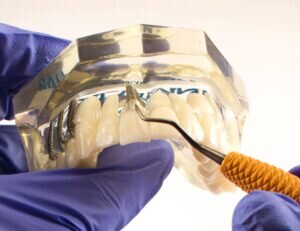
Hygienist scaling an anterior implant.
The chief complication to be aware of NOW is the removal of the oxide layer on titanium implants. According to Dr. Georgios Kotsakis: “Mechanical and chemical influences can lead to release of titanium particles. More effective treatments need to focus on not just biofilm removal but also the preservation of titanium surface passivation without abrasive effects.”2
Protecting the titanium implant surface affects all that we do as hygienists. The assessment, maintenance, home-care recommendations, and disease treatments. What we use to debride, polish, varnish, and recommend for home-care is in question.
The good news is that peer reviewed scientific panels from the American Academy of Periodontology (AAP), European Federation of Periodontology (EFP), and Academy of Prosthodontics (AP) groups have outlined guidelines to follow based on research.3-5
The American College of Prosthodontists published Clinical Practice Guidelines for Recall and Maintenance of Patients with Tooth-Borne and Implant-Borne Dental Restorations. Highlights featured include:6
- Use powered instruments such as the glycine powder air polishing system
- When clinical signs indicate need for occlusal device, educate and fabricate an occlusal device to protect fixed restorations and implants
- Patients with restorations should be advised to use oral hygiene aids: dental floss, water flossers, air flossers, interdental cleaners, and electric toothbrushes
- Implants: Use instruments compatible with the type and material of abutments, implants, and restoration
- Recall provided at least every 6 months
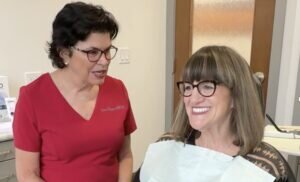
Author offers home care instruction to an overdenture patient.
Home-care has a new level of importance for implant patients with biofilm now considered one of the major risk factors causing peri-implant disease. Implants are not the same as natural teeth, they are a medical device. Implants can collect more biofilm, and studies show 80-85% of biofilm should be removed twice daily.
My presentations include the latest research on what products are safe for implant maintenance and for patients to use for homecare. An example is whether Fluoride (FL) is safe to use around implants. One FL stands out in the prevention of peri-implant disease: Stannous FL.
In a recent study in the peri-implant space, Stannous FL demonstrated to reduce inflammation and bleeding by 63% for mucositis patients after 3 weeks. Three times the protection than other Fluorides, it reduces biofilm for up to 8-12 hours and is now considered by the 2025 Darby and Walsh textbook to be the ‘gold standard’ of fluorides.7,8
Therefore, a personalized routine is now recommended for every implant patient to establish a home-care routine after the implant is restored to extend the life of the implant, prevent peri-implant disease, and for patient’s overall health.9
Hygienists play a key role as ‘first responders’ to provide patients:
- Professional IN-OFFICE maintenance at least every 6 months
- Identify biofilm and professionally remove
- Debride with safe hand scalers / ultrasonics
- Apply antimicrobial varnish, prevention of biofilm formation
- Establish a personalized home-care routine for patients to remove 80-85% of biofilm twice daily.
- Monitor implants for early intervention from peri-implant disease
Educating our next generation of hygienists in implant maintenance is critical. Over 3 million people have implants and every year 5 million new implants are placed. Hygienists need to be trained in safe implant maintenance, be able to recommend effective home-care, and detect early signs of implant complications for early intervention.
____________________________________
References
1. Lee C., Huang YW., Zhu L., and Weltman R. “Prevalences of Peri-Implantitis and Peri-implant Mucositis: Systematic Review and Meta-analysis.” Journal of Dentistry 62 (2017): 1-12.
2. Kotsakis G. et al. “Effect of Implant Cleaning on Titanium Particle Dissolution and Cytocompatibility.” Journal of Periodontology, 2021.
3. Berglundh T., Armitage G. et al. “Peri-implant Diseases and Conditions: Consensus Report of Workgroup 4 of the 2017 World Workshop on the Classification of Periodontal and Peri-implant Diseases and Conditions.” Journal of Clinical Periodontology 45, Suppl 20 (2017): S286-S291.
4. Herrera D. et al. “Prevention and Treatment of Peri-implant Diseases: The EFP S3 Level Clinical Practice Guidelines.” Journal of Clinical Periodontology, 2023: 1-73.
5. Wingrove, S. Peri-Implant Therapy for the Dental Hygienist: 2nd Edition. Wiley.
6. Bidra A., Daubert D., Garcia L., Kosinski T., Nenn C., Olsen J., Wingrove S., Chandler N., and Curtis D. “Clinical Practice Guidelines for Recall and Maintenance of Patients with Tooth-Borne and Implant-Borne Dental Restorations.” Journal of Prosthodontics 25 (2016): S32-S40.
7. Ramji et al. Journal of Dental Research (Special Issue A) 103 (2024): Abstract 2509.
8. Pieren J. and Godbury-Amyot C. Darby & Walsh Dental Hygiene, 6th Edition. Elsevier, 2025.
9. Wingrove S. “Personalized Oral Hygiene Technology – WHY it matters!” Compendium of Continuing Education in Dentistry 43, Sup1 (April 2022)
____________________________________
 Susan Wingrove, BS, RDH is a dynamic innovator, writer, researcher and international speaker. Susan is the recipient of the 2016 RDH Hygienist Award of Distinction and the 2022 Western Society of Periodontology Hygiene Educator of the year award. A member of the ADHA, IFDH and WSP, Susan is a highly-skilled researcher, contributor to multiple product developments, instrument co-designer of the Wingrove Titanium Implant Series, ACE probes and Queen of Hearts instruments for PDT, Inc. Susan specializes in providing presentations, webinars and workshops on protocols that follow the science for healthy teeth, implants and disease treatment. She is a published author in American and international journals on peri-implant therapy, regeneration, advanced instrumentation, customizing patient home-care and the textbook: Peri-Implant Therapy for the Dental Hygienist: 2nd Edition. Learn more on her website at wingrovedynamics.com. Susan resides in Missoula, Montana, where she enjoys fly fishing, hiking and snowshoeing.
Susan Wingrove, BS, RDH is a dynamic innovator, writer, researcher and international speaker. Susan is the recipient of the 2016 RDH Hygienist Award of Distinction and the 2022 Western Society of Periodontology Hygiene Educator of the year award. A member of the ADHA, IFDH and WSP, Susan is a highly-skilled researcher, contributor to multiple product developments, instrument co-designer of the Wingrove Titanium Implant Series, ACE probes and Queen of Hearts instruments for PDT, Inc. Susan specializes in providing presentations, webinars and workshops on protocols that follow the science for healthy teeth, implants and disease treatment. She is a published author in American and international journals on peri-implant therapy, regeneration, advanced instrumentation, customizing patient home-care and the textbook: Peri-Implant Therapy for the Dental Hygienist: 2nd Edition. Learn more on her website at wingrovedynamics.com. Susan resides in Missoula, Montana, where she enjoys fly fishing, hiking and snowshoeing.
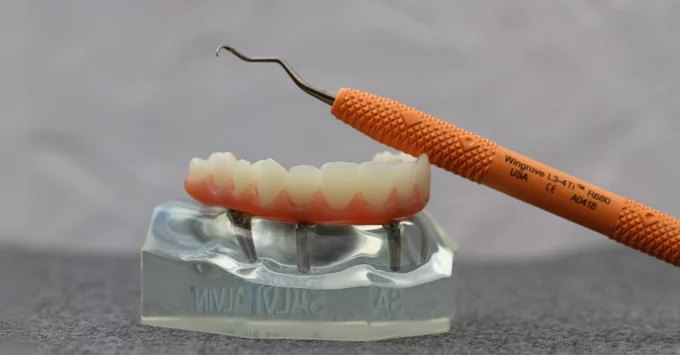
 Audio Version
Audio Version